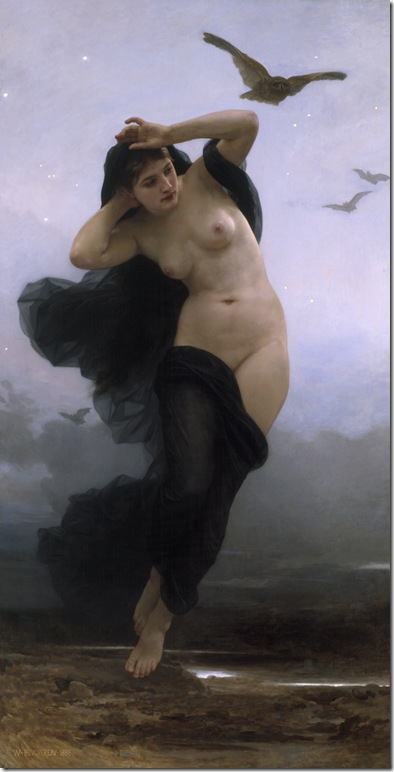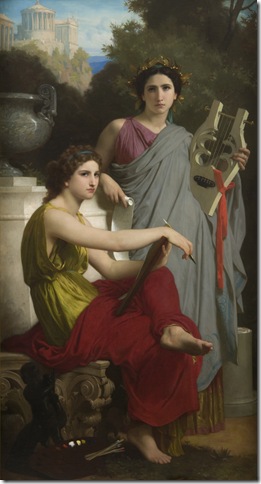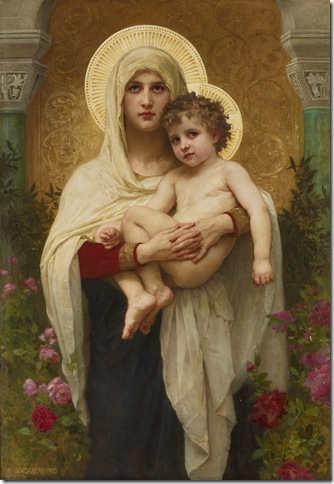In true dramatic fashion, he went from being the trendy artist everyone desperately copied to being something like the universal symbol for what to avoid.
What else is new?
The fame, popularity and recognition enjoyed by French academic painter William-Adolphe Bouguereau in the 19th century no doubt landed him in the history books. When else have America and Europe been on the same page? The whole world was, for a moment in time, when it came to Bouguereau’s art.
Looking at his 1883 La Nuit (Night) oil painting it is easy to see why. This time of day announces its arrival in the shape of a life-sized, barely-clothed female flying over a coast. Her commanding and erotic presence is accompanied by nocturnal creatures such as owls and bats.
It is not clear whether she is guarding herself from their wings or is about to issue them an order. Her graceful pose highlights the skin treatment that characterized Bouguereau. There are the rosy lips and cheeks, but we also notice the hint of blue lending the flesh a more realistic appearance.
This is one of 19 artworks explored by Flagler Museum’s winter exhibition, Bouguereau’s Fancies. It aims to reintroduce us to the man behind the sentimental and idyllic scenes featuring nymphs, flawless nudes and cupids. Today, the mythological and allegorical romantic paintings that built his reputation hang at the Louvre and the Museé d’Orsay in Paris and the Metropolitan Museum of Art in New York, to name a few. They are the focus of Bouguereau’s “Fancies,” which ends April 19.
The first glimpse of Jeune fille se défendant contre l’Amour (Young Girl Defending Herself Against Eros) can leave us speechless. In it, a young girl pushes away the Cupid boy to avoid the touch of his arrow. As in other works, a blue cloth suggesting purity semi-covers her nudity while a gentle expression is painted on her face. She looks lovingly at the boy of golden curls and small wings, as if saying: you are adorable but no, thanks. The boy, though determined, doesn’t stand a chance against her strong, extended arms.
Three versions of this scene are displayed in the second gallery room. It is the first time they are shown together. The larger 1880 version, once owned by Henry Flagler and displayed in Whitehall’s Music Room, has the most vibrant colors. It is accompanied by the artist’s reduced version, once owned by Henry Flagler’s friend Henry Walters, as well as a chalk-and-gouache drawing with the same theme.
Had it not been for his excellent technical skills, such an artwork could have ended up being obscene. Instead, Bouguereau manages to make it elegant and makes the plot stand out more than the porcelain flesh.
All the works on display, plus the porcelain, marble and bronze reproductions of the period, can easily be seen in one hour. Some of that time should be spent by Reflexion (Reflection), an enigmatic piece in the third room that deserves extra minutes because its lack of reference. The half-nude girl sports a slightly longer face than the other females in the show. She looks sadder, neutral, while staring at us. She is waiting for us to decide what to make of her. By the time we reach this piece, we are so spoiled by the easy-to-grasp titles and romantic subjects that we do not know what to think of it. Who is the girl? Where is her smile?
The show well is balanced and includes daydreaming, seductive girls as well as toned-down subjects in the spiritual vein. One of them is La Charité (Charity), which makes the case for a grounded artist preoccupied with universal concepts such as happiness and hope. Here, Bouguereau depicts a Mary-like mother dressed in blue holding two sleeping babies in her arms. We are told the innocent infants could represent Christ and St. John the Baptist or perhaps human souls in need of Mother Church. It is a touching portrait of maternal love showcasing, once again, the artist’s skillful handling of the human figure.
Because the art world has always craved conflict and rough edges, the favorable consensus on Bouguereau’s style did not last. Refined and controversy-free, his pieces lost popularity to modern tendencies and artists, such as the Impressionists, whose work he had rejected earlier while serving as a judge in the famous annual Salon in Paris. Karma is a pain. The only thing he inspired in those days was the term Bouguereauté, which defined an approach rooted in academics and idealism.
To this day, Bouguereau divides a crowd into loyal fans and haters. The subtitle of the exhibit, Allegorical and Mythological Works by the French Master, does not leave room for a debate on this. He is a master. He was influential. End of story. The exhibition does not claim that he was the most daring one. At the risk of sounding like a green-tea proverb, sometimes we ought to let the universe fill us with beauty.
The artist himself said as much in 1895. “I see only the beautiful in art and, for me, art is the beautiful. Why reproduce what is ugly in nature?”
Bouguereau’s ‘Fancies’ can be seen at the Flagler Museum on Palm Beach through April 19. Regular ticket prices: Adults: $18; $10 for youth ages 13-17; $3 for children ages 6-12; and children under 6 admitted free. Hours: 10 am to 5 pm Tuesday through Saturday, noon to 5 pm Sunday. For more information, call 561-655-2833 or visit www.flaglermuseum.us.




